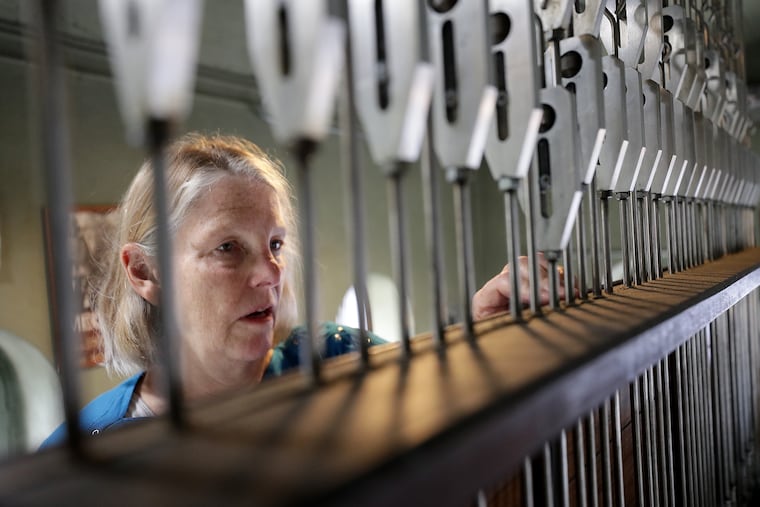Meet the woman who plays Germantown’s ‘truest public instrument’
The 118-year-old carillon bells at Miraculous Medal Shrine serve as musical outreach to those who might not come inside for church.

Every Monday at noon, a pleasant chiming of bells rings out across the lawn of the Miraculous Medal Shrine, a Roman Catholic church in East Germantown. They’re typical sounds one can expect to hear near a church, but listen closely and you’ll catch the intricate melodies of the Marian hymns carillonneur Janet Tebbel plays for novena attendees.
“The carillon is a very expressive instrument,” said Tebbel, who has been playing at the church since 2002. She first learned how to play the carillon, an instrument with at least 23 bells arranged in chromatic sequence, at the University of Michigan, where she studied music. “What makes it special is that every single carillon is a little different. They all play slightly differently.”
Philadelphia is considered a national hot spot for carillons, according to Tebbel, who also plays at the First United Methodist Church in Germantown.
There are more than 180 carillons in North America, and nine of them are located in the area, including the ones at Longwood Gardens and Washington Memorial Chapel in Valley Forge. Next year, Longwood Gardens will host the annual gathering of the Guild of Carillonneurs in North America and the World Carillon Federation.
Carillons originated in the Netherlands and Belgium, evolving from swinging bells that were used to alert townspeople to church services, and warn them of fires and wars, into an instrument that could play melodic compositions. The bells are played from a keyboard that looks like a simpler version of an organ, with handles for the carillonneur’s hands and pedals for her feet connected to the bells’ clappers with wires.
The carillon at the Miraculous Medal Shrine came into existence at the turn of the 20th century.
In the late 1890s, a Germantown-based member of the Vincentian society of priests and brothers visited the Church of Notre Dame in Buglose, France. There, he was inspired by the church’s carillon, which consisted of 60 bells. After he returned to Philadelphia, he persuaded the Vincentians to install a bell tower and carillon in St. Vincent’s Seminary chapel, which eventually became the Miraculous Medal Shrine.
Upon its completion, the Vincentians ordered a carillon of 26 bells from the Paccard Foundry, a famous bellmaker in the French Alps. The foundry cast France’s largest bell — the “La Savoyarde” for the Sacre-Coeur basilica in Montmartre, Paris — in 1891.
After the 125-foot bell tower was completed in 1899, the carillon made its musical debut on Easter in 1901. But in its first 40 years, the carillon was often silent due to mechanical problems, upgrades, and Prohibition — the original donation for the instrument came from a pre-Prohibition liquor business.
That changed when Arthur Bigelow, Princeton University’s first carillonneur, came for a visit in 1943.
“He was an absolute bell aficionado,” Tebbel said. “He traveled the world looking at bells, and after he immigrated to Princeton because of the war ... the Vincentians invited him to take a look at the carillon. Bigelow wound up writing an impassioned letter about the state of the bells — saying that they have no tongues, that they were “hanging willy-nilly” — and the church got the money they needed to fix that.”
The church expanded the carillon to 47 bells and recast the original Paccard bells in Bigelow’s studio that same year. Bigelow himself became the church’s carillonneur in 1952.
More than 75 years after the expansion of the carillon, the church continues to maintain the instrument, according to the Rev. Michael J. Carroll.
“Clearly there’s a commitment to the carillon because there’s an expense in maintaining it,” Carroll said. “It plays a part of what we do here and the message we share with people. Bells offer us a way to speak with people who don’t make it into the church, and it’s part of our outreach.”
Today, Tebbel climbs 70 rickety steps to the keyboard room underneath the carillon. As she plays a rendition of “A Whole New World” from Aladdin before the novena, she leaves a window cracked to hear the music.
“It’s truly such a public instrument,” Tebbel said. “You can play a bagpipe inside, but you definitely can’t play a carillon inside.”